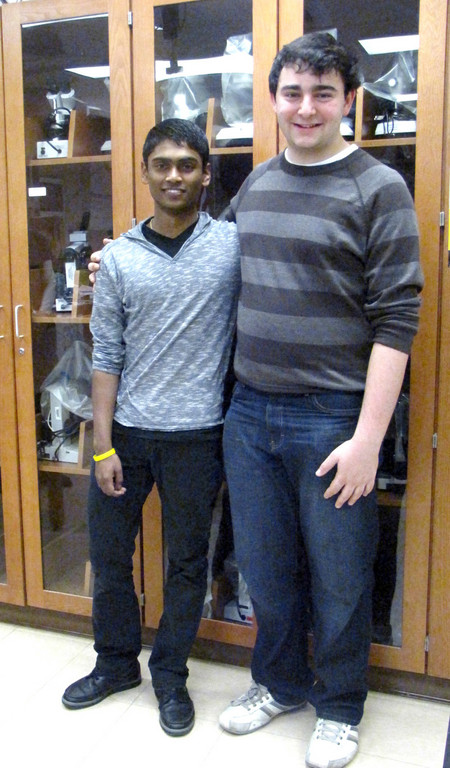Two Oceanside High School students are Intel semifinalists
Two Oceanside High School seniors have been named semifinalists in the 2012 Intel Science Talent Search.
Anoj Ilanges and David Allan Sheynberg were recognized for their projects on oncology and eating behavior, respectively. They are among 300 semifinalists chosen from a total of 1,839 participants in the competition.
Ilanges decided to study the effects of alcohol on the growth of tumors in the body when there are certain mutations present, by using genetically modified fruit flies. According to Ilanges, the body’s hippo pathway acts as a tumor suppressor, but it has a stress response that can be negatively affected.
“That’s why I thought that alcohol is both a stress source and it’s known to be a carcinogen linked to multiple cancers, but that it hasn’t been identified how it’s linked to cancer,” he said. “I found that the overgrowths seen when the mutations are present get enhanced and [are] made worse by the consumption of alcohol.”
Ilanges has narrowed his study further since last summer, when he began his project, by focusing on how alcohol affects cancer growing in the liver. “That’s the organ that is hit the most, besides the eye and the wing [of the flies] that I originally looked at,” he said.
He added that the fat body in the fruit fly is similar to the liver of a human. “Ninety percent of all cancer-related genes, for example, are conserved from flies,” Ilanges said. “There’s great applicability, even though you wouldn’t think a fly and a human have anything in common at all.”
By “knocking down” the hippo pathway in the flies — by breeding two parent flies to develop a genetic mutation — Ilanges found that the hippo pathway has a very strong role in the liver. The mutation he created in the flies is seen, he said, in 30 percent of all liver cancer cases.
His project was selected as a semifinalist for the Siemens competition earlier in the school year.
Sheynberg worked in a new field, social neuroscience, to determine how calorie labels on products affect the way people purchase and eat food. Using a Functional Magnetic Resonance Imaging, or FMRI, machine, he determined which areas of the brain are active when we look at menus and labels.
“There was a region called the inferior parietal lobule that was active when people looked at menus, and that area of the brain is responsible for calculations, as opposed to decision-making,” Sheynberg explained. “It has been associated with just numerical values.”
Based on his results, Sheynberg determined that using labels is more of a calculation than a decision, and for that reason, labels should include daily recommended intake of calories. “If a person looks at a burger that has, let’s say, 600 calories, they’re not going to be able to make that choice as effectively when they don’t know you should be eating about 2,000 calories in a day,” he said. “The numerical dominance of those figures when you’re making decisions prompts for more information.”
Sheynberg also studied the differences in brain activity when a person decides to eat a high-calorie food rather than a low-calorie food. He discovered that decisions to choose high-calorie foods tended to be based in brain regions associated with emotion, motivation and reward, while choices of low-calorie foods were based in regions associated with “rational, executive decision-making.”
The majority of the work Sheynberg and Ilanges did for their projects was completed at labs last summer, though Ilanges has continued work on his project every day after school. Sheynberg worked with Dr. Joy Hirsch at Columbia University’s FMRI Research Center, while Ilanges works with Dr. Cathie Pfleger at Mount Sinai Hospital.
Aside from his schoolwork, Sheynberg has taken part in a number of extracurricular activities, including performing with the high school thespians and the All-State choir, and acting as the general organization president of the student government and vice president of the World Interest Club.
Ilanges was a three-sport athlete prior to his research, participating in soccer, track and cross-country, though he decided to devote his free time to his project this year. He had also played saxophone in the school band, but he had to stop because he leaves early to travel into New York City every day.
Sheynberg will attend Harvard University in the fall, while Ilanges hopes to go to Princeton University.
On Jan. 25, Intel will choose 40 finalists in the competition, who will travel to Washington, D.C., in March for the final round of judging.






